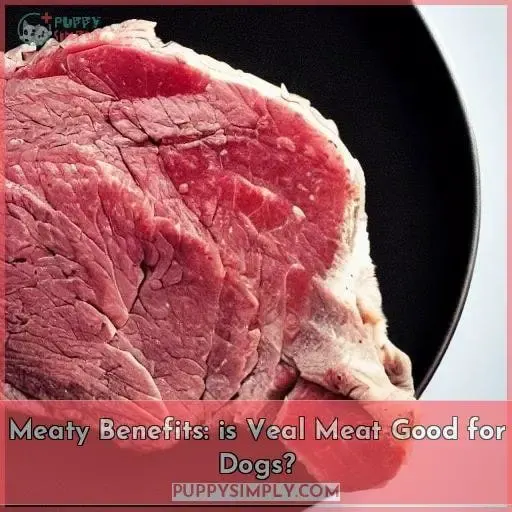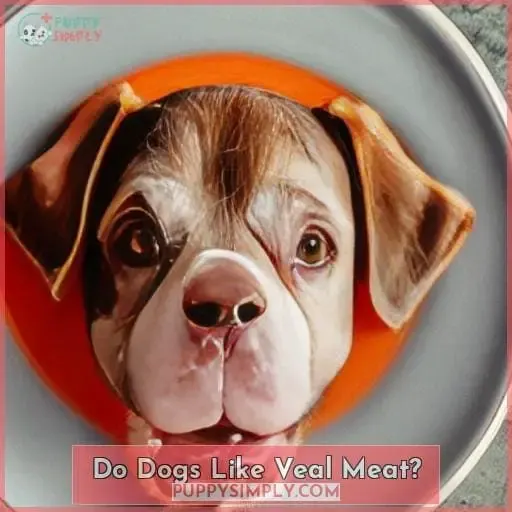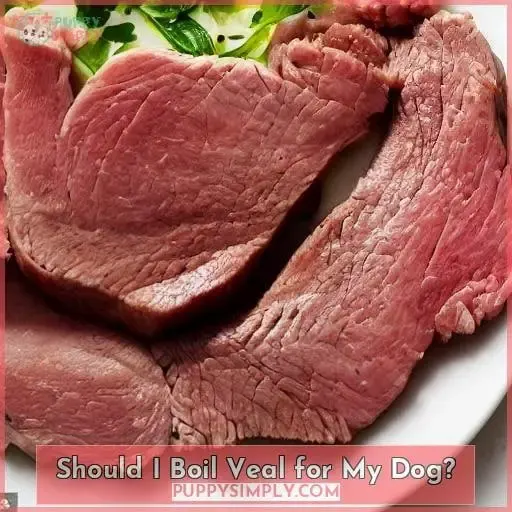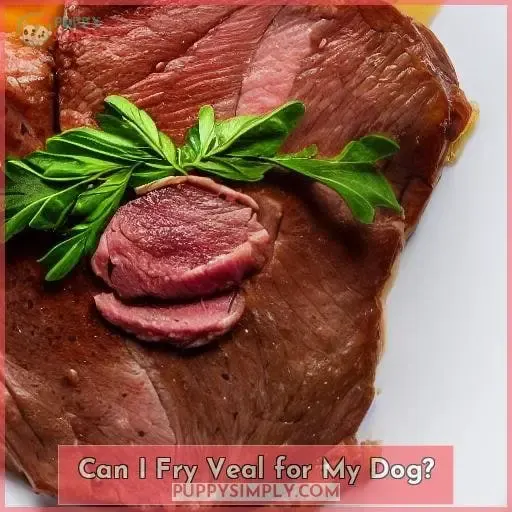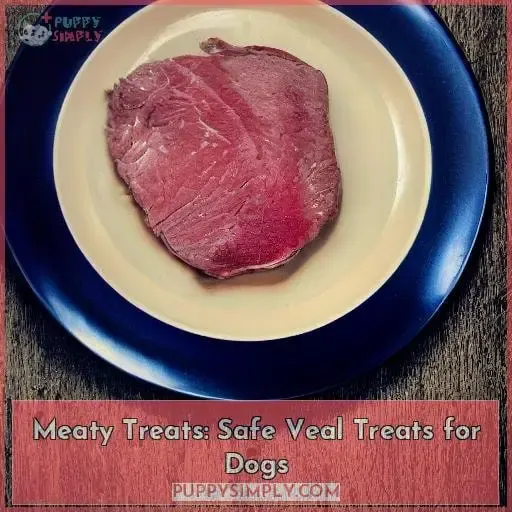This site is supported by our readers. We may earn a commission, at no cost to you, if you purchase through links.
Do you love your pup but wonder if veal is something they can eat? You’re not alone! Nearly 70% of pet owners want to know what their furry friends should and shouldn’t be eating.
Veal has long been a staple in many households. It’s no surprise people are asking if it’s suitable for dogs.
This article provides an answer, breaking down the nutritional benefits of veal meat as well as potential risks.
Find out if veal is a safe option for your pet!
Table Of Contents
- Cracking the Answer: Can Dogs Eat Veal Meat?
- Worth It or Not: is Veal Good for Dogs?
- Meaty Benefits: is Veal Meat Good for Dogs?
- Do Dogs Like Veal Meat?
- Can Dogs Eat Veal: Nutritional Facts
- Benefits of Veal Meat
- Risks of Feeding Veal Meat to Dogs
- Should I Boil Veal for My Dog?
- Can I Fry Veal for My Dog?
- Meaty Treats: Safe Veal Treats for Dogs
- What Else Should I Feed My Dog Along With Veal?
- Is It Recommended to Feed Veal to Dogs?
- How Much Veal is Too Much Veal: the Safe Quantity?
- What Are the Alternatives of Veal to Dogs?
- Frequently Asked Questions (FAQs)
- Conclusion
Cracking the Answer: Can Dogs Eat Veal Meat?
Discovering if your furry friend can enjoy the benefits of veal meat is a simple process and you’ll soon be able to give them this delicious treat. Veal offers an excellent source of lean protein, vitamins B6, B12 and niacin, iron as well as zinc which are all important for energy levels in four-legged friends.
However, it’s important to consult with a vet or nutritionist first before feeding any type of meat to your dog. If veal isn’t suitable, there are several nutritious substitutes such as beef, lamb, chicken or venison which provide similar nutritional benefits.
When preparing veal meals from scratch at home, make sure the cuts used have been cooked properly without added fat or salt content. Frying food isn’t recommended either! Additionally, ensure that no bones remain in the meal since these can cause injury due to splintering when chewed on by dogs, leading to digestive issues. Rice works particularly well when served alongside a portioned cutlet, providing further energy boost too!
With some careful preparation, you now know how beneficial eating veal can be for dogs. So why not try out recipes yourself?
Worth It or Not: is Veal Good for Dogs?
Deciding whether veal is a good choice for your canine companion can be overwhelming. But with the right knowledge, you’ll have no trouble giving them all the nutrition they need!
Veal provides several health benefits to dogs: protein, iron and B vitamins. It’s also more tender and easier to digest than beef, making it an ideal option for those with digestion concerns.
But feeding dangers might arise from ground veal or veal meatballs due to its higher sodium content. So these should only be offered in moderation as treats, not regular meals.
Food allergies are always a concern when introducing new foods into your dog’s diet. So watch out for any reactions before offering large amounts of it over time.
In short: yes, if done properly, veal can make a safe and nutritious meal option for your pup – provided you source quality ingredients from reputable suppliers!
Meaty Benefits: is Veal Meat Good for Dogs?
Veal provides a lean, vitamin-rich protein source that can benefit dogs when served in small portions. It contains essential fatty acids along with minerals such as iron, B vitamins, zinc, niacin, and vitamins B6 & B12 – all of which are important for boosting immune systems and aiding digestion.
When feeding veal to your pup, it’s best to start slowly with only a few grams of lean veal meat per day due to its higher sodium content than other meats like chicken or beef. This will help you gauge any digestive issues they may have from raw consumption or sensitive stomachs in general before increasing servings over time.
Always make sure that you purchase high-quality products free from hormones or antibiotics, as these can be detrimental health-wise for both humans and animals alike!
Don’t forget to include some healthy fats into their diet; try adding some cooked liver pieces alongside their daily meals to get an extra boost of nutrition without having to worry too much about overeating on calories!
Discover if veal meat is the right choice for your pet’s nutritional needs by exploring the benefits and considerations.
Do Dogs Like Veal Meat?
Do you want to give your pup something special that can both satisfy their taste buds and provide a boost of essential vitamins, minerals, and proteins? Then veal could be the perfect choice! Veal is a lean protein, rich in B-vitamins such as niacin, vitamin B6 and B12. It also contains iron which helps with red blood cell production.
A balanced diet for doggies should include some meat sources like veal or other alternatives like beef or lamb to get all the necessary nutrients. If your pup’s allergic to veal, there’re still plenty of options on the raw food diet market for them! Cooking variations range from lightly cooked dishes with low sodium levels to steaks prepared rare – just make sure to serve them well done if using bones so they don’t cause injury or choking hazards!
With all this in mind, it’s clear why introducing some delicious yet beneficial cuts of veal into your dog’s daily menu would be an excellent choice!
Can Dogs Eat Veal: Nutritional Facts
You may be surprised to learn of the nutritional benefits veal can offer your furry companion. It’s a lean protein source, rich in iron and B vitamins essential for red blood cell production and anemia prevention. It has high levels of niacin, vitamin B6, B12, and zinc, and is low in fat and cholesterol compared to beef options. This makes it a great choice for dogs on raw feeding diets or anyone looking for alternative sources of canine nutrition.
When preparing veal meals or treats for your pup, make sure to get them from trusted suppliers who grass-fed their livestock only. That way you know they’re free from hormones and additives that could cause meat allergies or other health issues with your pet down the line. Calcium sources such as bones should be avoided when serving cooked meals, since these can easily splinter off, causing injury or choking hazards while digesting if not prepared properly before feeding.
All things considered, veal provides plenty of nutritional content suitable for good health maintenance, so keep it in mind next time you consider protein sources in meal prepping!
Benefits of Veal Meat
Veal meat is an excellent source of lean protein and contains several vitamins and minerals that can help boost energy levels in dogs. It’s a great option for dogs with allergies, as it has lower fat content than beef. Veal also provides essential amino acids which are important for muscle development, tissue repair, and improved skin health.
It’s an ideal choice for dogs who need extra nutrition but are on restricted diets. It’s also low in cholesterol, making it a healthier option. Additionally, veal is rich in iron and zinc, both of which are essential for a healthy immune system.
1 Excellent Source of Lean Protein
Veal is an excellent source of lean protein for your pup. It provides the essential vitamins and minerals needed to keep them healthy. This red meat alternative offers more nutrition than processed treats or store-bought food, making it a great choice when you’re creating an at-home diet.
It’s high in iron and B vitamins such as niacin, vitamin B6, and B12. This helps boost energy levels and aids in muscle development and tissue repair. It also contains zinc which helps with digestion, as well as skin health maintenance, making it ideal for raw feeding diets that require fresh ingredients.
Plus, compared to beef products on the shelves today or in fast food restaurants, veal has lower fat content. But it still provides all the protein benefits without taking away from the overall nutrition labels found on other meats like chicken or sweet potato!
2 Boosts Energy Levels
Veal is an excellent source of energy for your pup, providing a boost to their overall vitality! With high protein and lower fat than beef, veal can help support red blood cell production and provide essential vitamins like B6 and B12. It’s great for those following a raw diet as it can be served cooked or uncooked. Plus, it’s easier to digest than beef, so you don’t have to worry about food allergies if you’re feeding ground veal.
Meal prepping with this healthy meat option is simple. Just make sure when adding seasoning or salt during cooking, you stick to the recommended levels on your dog’s daily feeding schedule.
3 Good for Dogs With Allergies
If your pup has allergies, veal could be the perfect solution. It provides an energy-boosting, nutritious meal that helps keep their skin and coat healthy. Veal is often more hypoallergenic than other meats, so it’s less likely to cause reactions. It also has a high protein content, which dogs with allergies need to stay healthy and behave well. Compared to other protein sources, raw ground veal is lower in sodium but still rich in fat. This makes it a great option for dogs with dietary requirements due to allergies.
4 Lower Fat Content
You can rest assured that veal is a low-fat option for your pup, so you don’t have to worry about weight gain. It’s the meat of young calves and usually has minimal sodium, making it one of the healthier options. Opting for organic sources will ensure humane treatment and fewer chemicals in their diet.
Following raw diets with proper portions can provide your dog with even more benefits due to its high content in vitamins B6, B12, niacin, and zinc. A balanced diet related to their breed should include plenty of vegetables along with veal meat.
But don’t overfeed them as this type of food contains very low fat levels compared to beef or lamb. This is an important consideration if you want a healthy pooch!
Risks of Feeding Veal Meat to Dogs
Feeding veal meat to your dog can be a nutritious and delicious treat. However, there are some risks associated with it. Veal liver and bones shouldn’t be fed, as they can cause choking or injury. Too much sodium in the diet can lead to health issues. Flatulence could occur if your pup overindulges on veal treats. Skin itchiness might result from an allergy-related reaction.
Talk with your vet before introducing any new food into their diet!
1 Veal Liver and Bones
Veal liver and bones can provide a nutrient-dense meal for your pup, offering essential vitamins and minerals to keep them healthy. Providing variety in their diet is key to ensuring they get the nutrients they need, but moderation guidelines must be followed when feeding veal or any type of beef.
It’s high in iron and B vitamins while being lower in fat than other types of beef. If you’re looking into homemade recipes for your dog, consider incorporating veal into the mix as long as it isn’t fried meat – heat sensitive ingredients like this should always remain raw!
Before making drastic changes to your pup’s diet, speak with a vet or consult staff writers from canine nutrition sites who specialize in understanding which breeds require special diets due to age considerations, etc.
2 Too Much Sodium
You should take caution when feeding veal to your pup. It contains high levels of sodium that may be detrimental if consumed in excess. Look for organic options with a lower sodium content or healthier alternatives such as beef or chicken. Consider different feeding strategies based on the size of your dog’s breed; smaller breeds might need less veal. Make sure the quality is good by checking for included fatty acids and other important nutrients like vitamins B12 and B6, which are essential for optimal health. Feed balanced meals with moderate portions to reduce the probability of overconsuming sodium from veal dishes you feed them at home or buy commercially prepared treats from pet stores.
3 Flatulence
Feeding your pup veal can lead to increased flatulence, so be mindful of how much you give them – too much and there’ll be trouble in the air! It’s important to consider dietary considerations and digestive issues when choosing food for your furry friend. Some dogs may also have food allergies, which can cause discomfort or worse.
To maintain nutrition balance for your dog’s breed, it’s best to mix up their diet with different options such as veal substitutes like beef, lamb, chicken or venison. Veal is a rich source of protein and high amounts of zinc that are beneficial for muscle development and tissue repair. But appropriate cooking procedures must always be followed, especially since cooked bones can cause injury or choking if ingested by accident.
Remember that while veal treats shouldn’t replace regular meals, they could still add variety into their diet provided they’re served in moderation alongside vegetables like carrots plus sweet potatoes on rice. This provides an energy boost without upsetting tummies!
4 Skin Itchiness
If your pup is experiencing skin itchiness, veal can be a great option. It provides lean protein and vitamins like B6 and B12, plus iron for red blood cells. Avoid rawhide chews and table scraps high in fat, like organ meat, to keep your pup from gaining weight. A grain-free diet with home-cooked meals featuring veal bones is ideal for many dog breeds with sensitive stomachs or allergies. It’s easier to digest than beef alternatives.
Should I Boil Veal for My Dog?
You may want to consider boiling veal for your pet. Boiling is one of the best methods for cooking veal, preserving its natural flavor and nutrition, and reducing fat content compared to other methods such as frying or grilling.
Use organic and grass-fed varieties whenever possible since these contain better protein content than those fed on grains or corn feedlot diets. Dogs should be given small portions based on their breed size and age; follow feeding guidelines when introducing cooked veal into a diet plan so they don’t get overfed or undernourished.
Avoid giving raw bones – these can cause injury due to shards splintering off during chewing. Opt for cooked bone-in cuts instead. These provide various benefits including improved digestion health, healthy skin coat maintenance, and increased energy levels thanks to higher vitamin B12 contents. This type of cut is specifically designed with canine nutritional needs in mind!
Can I Fry Veal for My Dog?
You may be wondering if you can fry veal for your pup. Let’s take a closer look.
It’s possible to deep-fry veal, but there are guidelines and precautions to reduce the risk of foodborne illness. Freezing veal before cooking isn’t recommended as this increases the chance of salmonella risks.
Homemade recipes should be given with caution and portion sizes adjusted for the size and breed of your dog.
When frying or deep-frying any type of meat including ground or cubed veal, make sure to follow the cooking guidelines provided on commercial pet food products for safety reasons when preparing meals for your four-legged friends at home.
There are also many substitutes such as beef, lamb, chicken, venison, bison, rabbit, goat, and quail which can provide additional protein sources without too much fat content.
Meaty Treats: Safe Veal Treats for Dogs
Treat your pup to some delicious, nutrient-packed veal treats that are as tender and juicy as a summer fruit. When it comes to feeding your dog, it’s important to consider their dietary needs based on their breed and size. Veal is a great option for dogs who need high-quality protein in their diet but may have trouble digesting beef or other meats.
One way to incorporate veal into your dog’s diet is through homemade veal recipes like meatballs or patties made from ground meat mixed with veggies like carrots or sweet potatoes. You can also find pre-made packets of ground veal at the grocery store that you can shape into ball forms perfect for training treats. Just be sure not to add any seasoning or salt since these ingredients could be harmful to dogs’ health when consumed in large amounts.
Another option is serving raw dog-shaped ground veal treats which offer all the benefits of cooked options without losing nutritional value due heating processes involved during cooking procedures.
The table below outlines different types of safe and nutritious ways you can feed your furry friend with tasty yet healthy meals containing this precious ingredient while considering his/her unique dietary requirements:
| Type of Veal Treat | Description | Benefits |
|---|---|---|
| Meatballs/Patties | Homemade balls/patties made from ground meat mixed with veggies such as carrots & sweet potatoes. |
What Else Should I Feed My Dog Along With Veal?
Along with veal, you can provide your pup with other lean proteins and healthy veggies for a balanced diet. Raw diets are becoming increasingly popular, offering unprocessed meats rich in protein and free of grain-based fillers. Cook at home? There’s an abundance of alternative meat choices, such as chicken, turkey, or even fish, all containing high amounts of protein for muscle growth. Incorporate different veggies, like sweet potatoes or carrots, into their meals daily. These provide essential minerals that’ll help keep your pup healthy. Ensure your pup’s breed gets the correct amount of Omega fatty acids in its diet. This helps maintain skin health and prevent allergies from environmental factors, such as pollen. Make sure each meal contains the right balance between nutrients, including veal, when feeding your furry friend!
Is It Recommended to Feed Veal to Dogs?
Yes, it’s recommended to feed veal to your pup. It contains high levels of iron and B vitamins which aid in red blood cell production, tissue repair and muscle development.
But before incorporating veal into your dog’s diet, consider factors such as their breed and any allergies they may have.
To ensure your pup’s safety when feeding them veal, follow safe cooking practices. Cooked bones can cause injury or choking, so avoid giving cooked veal bones. Also be mindful of the temperature at which you serve cooked meat to prevent burns. If rawhide treats are a part of your pup’s diet, limit serving size as overconsumption could lead to digestive problems like constipation.
When planning homemade meals for dogs with hypoallergenic diets, remember not all foods work well together according to canine nutrition experts. Vegetables should comprise 50%-75% weight-wise, while proteins from animal sources (veal included) need only take up about one-third. The remaining percentage goes towards carbohydrates like rice which provides energy without raising insulin levels too quickly due its low glycemic index score compared to sugary snacks found on store shelves.
How Much Veal is Too Much Veal: the Safe Quantity?
You want to ensure your furry friend is getting all the nutrition they need without overdoing it with veal – so how much is too much? The recommended amount varies on size, breed and age. Generally, an adult dog should get no more than 10% of its daily diet from fatty meats like veal.
Avoid storing or freezing raw bones; they can be hard to digest. When buying in bulk or feeding large amounts, buy lean cuts free from hormones and additives. This prevents potential health problems later.
Veal may have higher fat than beef, but it’s a nutrient powerhouse. It’s low-fat protein sources like iron and vitamins B6 & B12 aid muscle development, tissue repair, and red blood cell production, preventing anemia.
What Are the Alternatives of Veal to Dogs?
Looking for something different to feed your pup? Check out these alternative proteins that can provide the same benefits as veal!
Raw meat alternatives such as chicken, beef and lamb are excellent sources of lean protein. Coconut oil is also a great source of healthy fat. Low-fat meats like turkey or rabbit offer plenty of nutrition without too much saturated fat.
Yogurt treats are also an option for providing extra vitamins and minerals in a fun way!
Grain free diets may be beneficial for some breeds – adding fish or eggs into the mix can provide additional protein with fewer calories than traditional meats.
Veal isn’t always necessary; there are other options available which might even be healthier if fed in moderation according to your dog’s breed and size. Plus, they all make part of a raw food diet – giving you more ways to boost your pet’s health while keeping them happy at mealtime!
Frequently Asked Questions (FAQs)
What are the signs of veal allergy in dogs?
If your pup is a picky eater or you’ve noticed any changes in various organ functions, they may be suffering from a veal allergy. Signs include redness around the mouth or paws, swelling and itching on areas exposed to raw veal like the feet, stomach discomfort after eating treats with beef-based proteins, and vomiting or diarrhea caused by contaminated food sources that contain traces of cow meat products like milk powder.
If these symptoms occur often enough that you suspect your pet might be allergic to this type of protein source, it’s best to consult a vet and switch up their diet, opting for alternatives such as lamb or chicken instead.
Are veal bones safe for dogs?
While veal bones may contain health benefits for your dog, they can also cause injury or choking if not monitored carefully. Rawhide chews and other healthier ways of providing protein, such as duck meat, lamb chops, vegetable stews and fish fingers, are recommended instead. They’re a safer option that, depending on your dog’s breed, requires little effort from you as the owner. These alternatives provide similar nutrients as veal bones, without risking potential harm!
How often should I feed veal to my dog?
Feeding veal to your dog can be a much better option than other animal proteins. It’s important to make sure you’re following dietary restrictions and portion sizes for the best results. Leaner treats like veal are great for dogs of all breeds, as they provide essential nutrients without the hassle of higher fat content.
Before introducing this type of meat into your pup’s diet, consider any allergy concerns or special dietary restrictions that may apply. The proper balance between nutrient-dense foods and leaner treats is key to ensure optimal health. So, when considering how often you should feed veal to your pup, remember moderation is key!
Are veal treats a good substitute for regular meals?
Veal treats can be a healthy alternative to regular meals for your dog. Especially if they are made from grass-fed livestock. It’s important to feed veal in moderation and consult your vet or nutritionist before introducing it into their diet.
Veal provides high levels of CoQ This helps muscle building, tissue repair and production of red blood cells. It’s also low in fat and cholesterol, making it an ideal choice for dogs with specific dietary needs due to breed or age.
Raw veal should be avoided altogether due to safety concerns. So make sure you cook the treats properly before serving them up!
What are the differences between veal and other meats for dogs?
Veal is a leaner and more tender meat than beef, making it an ideal choice for dogs. It’s high in protein and rich in vitamins B12, B3, and B6, as well as minerals like iron, which help support healthy red blood cell production. The lower fat quality makes veal a healthier alternative to red meat, which can lead to weight gain or obesity, depending on your dog’s breed.
When preparing veal for your pup, make sure you mix the portion with other recommended vegetables, such as carrots or sweet potatoes, to balance out sodium levels without compromising flavor. Veal can be served raw or cooked, but always check with your vet before introducing any new food into their diet due to common allergies some breeds may have towards certain meats.
Conclusion
You’ve made it to the end of the article and now you know all you need to know about feeding veal to your pup. The nutritional benefits of veal for dogs and the precautions to take when introducing it into their diet are clear. Imagine your pup’s eyes lighting up when you serve them veal, and your heart filling with joy when their coat looks shinier than ever. Feeding veal to your pup can keep them healthy and happy. So, go ahead and give them a taste. Enjoy watching them reap the rewards.



